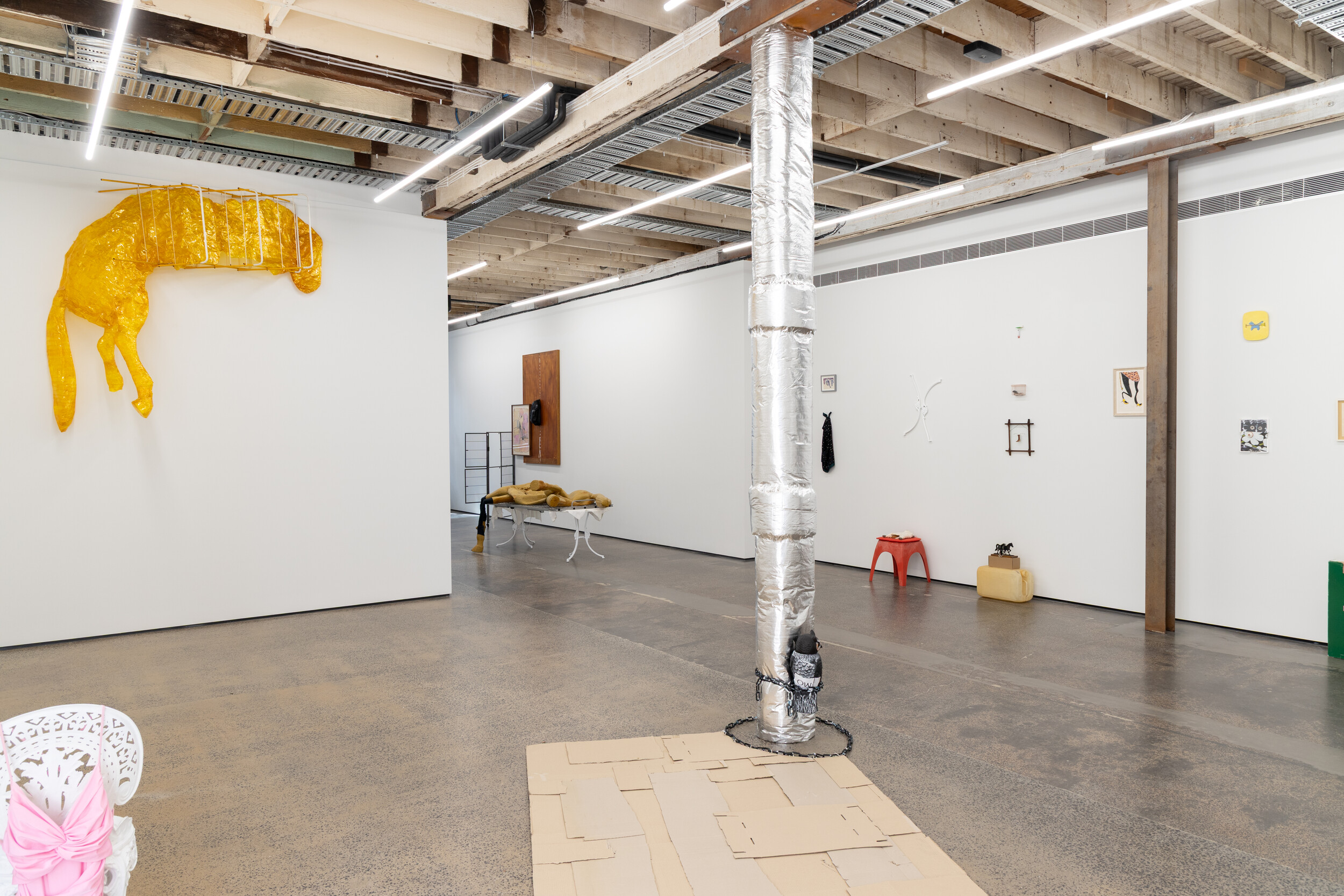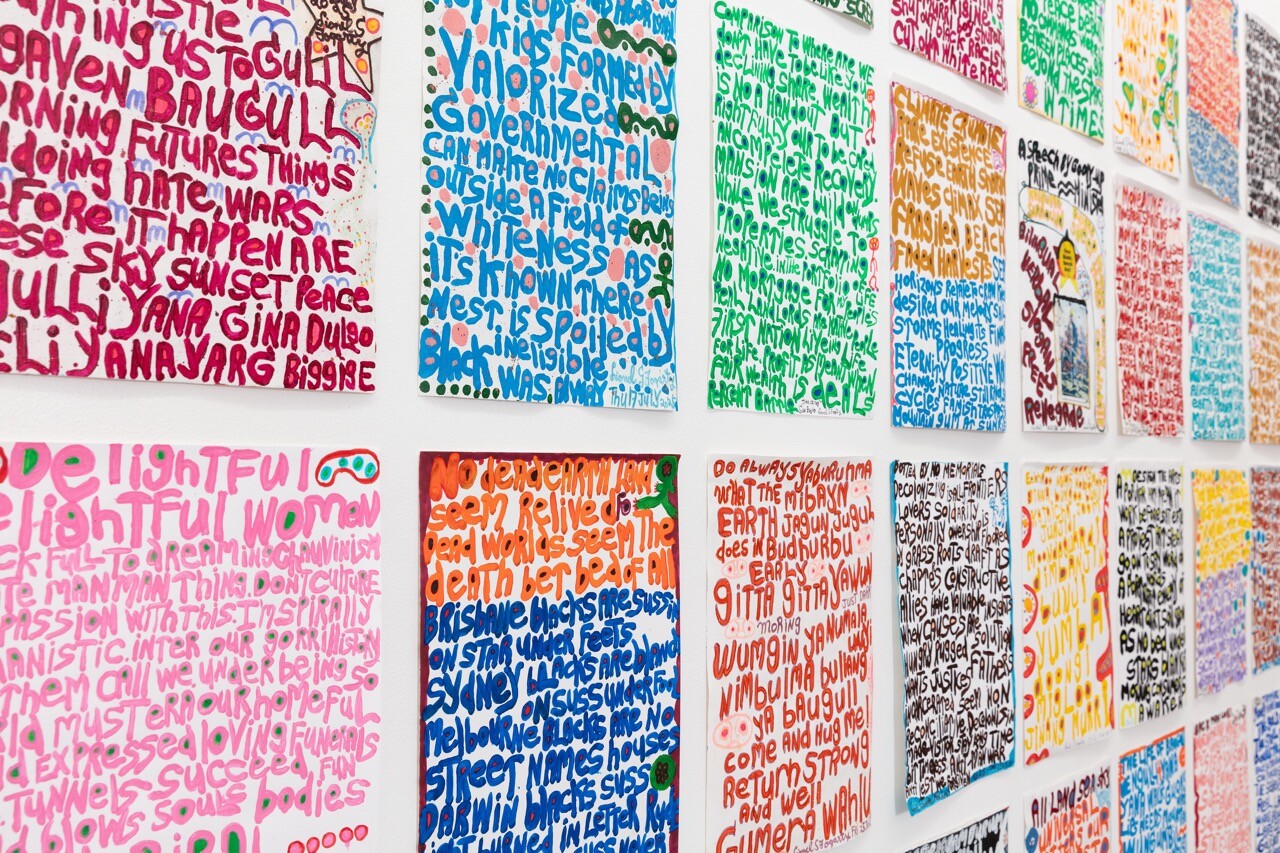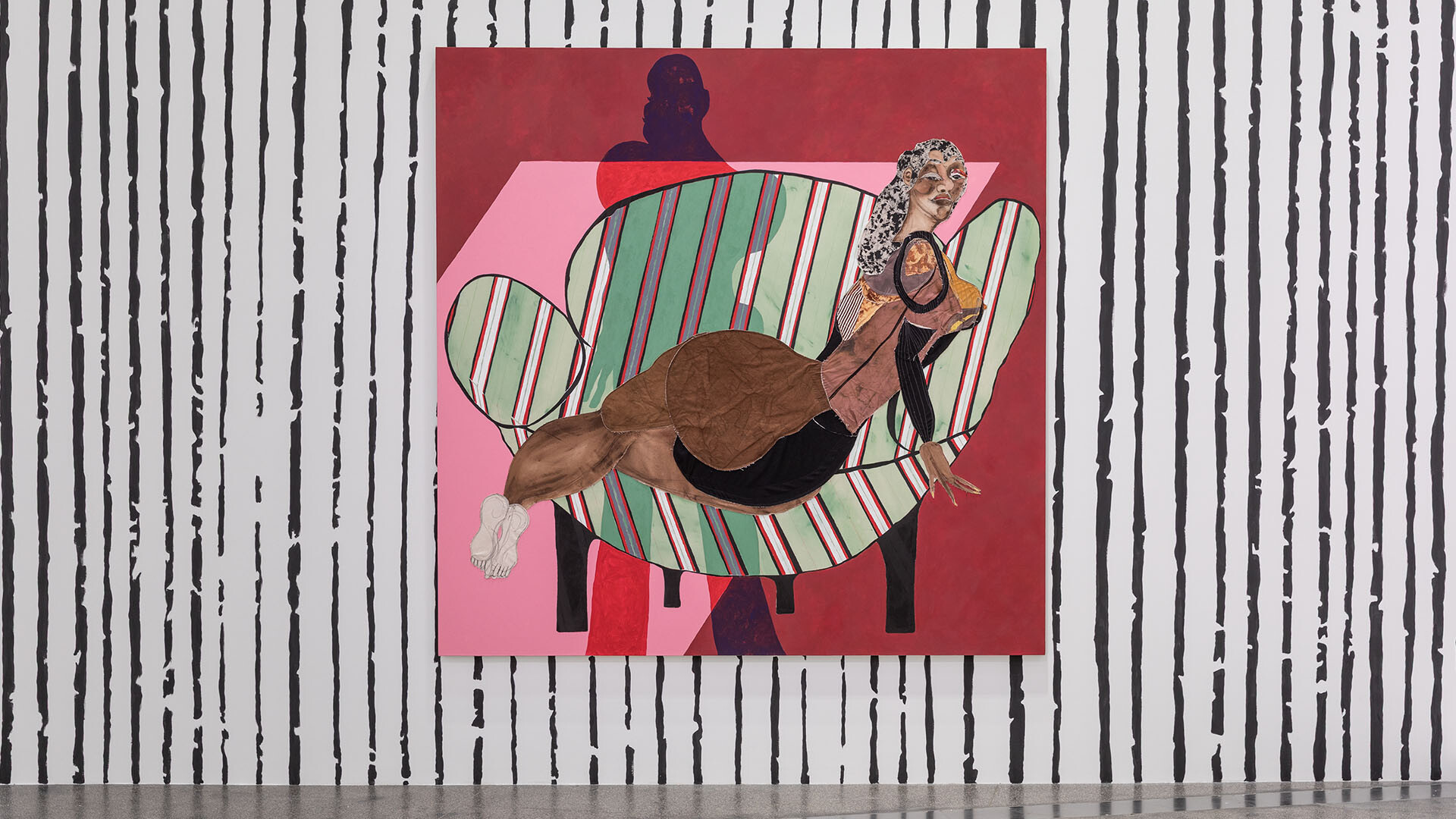Installation view of Aftershocks: Nolan and the Holocaust, Melbourne Holocaust Museum. Photo: Simon Shiff
Aftershocks: Nolan and the Holocaust
Rex Butler
Martin Amis’s The Zone of Interest, which was recently turned into a film, is about the lives of the family of a Nazi concentration camp commandant, who impossibly live without seeming to acknowledge what is happening next to them. The novel details their daily rituals—the gardener tending the garden, the wife’s flirtations with a junior officer, cocktail parties at night—without once mentioning the appalling atrocities they would see if they ever left their “zone of interest” to look. This is Amis at one point describing this fenced-off area surrounded by the camp in which the SS personnel and their families spend their time:
The ground levelled out, levelled out into what might have been a municipal facility in the square of some indigent township in the German north-east—two swings, a ride, a seesaw, a sandpit. There were small clusters of women on benches, one trying to read a flimsy newspaper in the wind, another knitting a yellow scarf, another extracting a sandwich from the shiny white folds of its greaseproof wallet.
Of course, the brilliance of the novel—or, perhaps equally put, its modesty—is that its real subject is the unrepresentability of the horrors of the concentration camp, or more generally the Holocaust. It is not only Commander Doll and his family who must remain unaware of the camp they live next to, but Amis writing their story—or not unaware, for the camp hovers over every sentence in the book, but Amis knows that he cannot relate what happened in there without dishonouring it, without giving it a form that is inappropriate to it. The real subject of Amis’s novel is not the family’s unawareness of the camp but his own inability to depict what happened there, the fact that all attempts to do so would be to miss it, fall short of it, not to see it, just like that Nazi family who are in a way all of us.
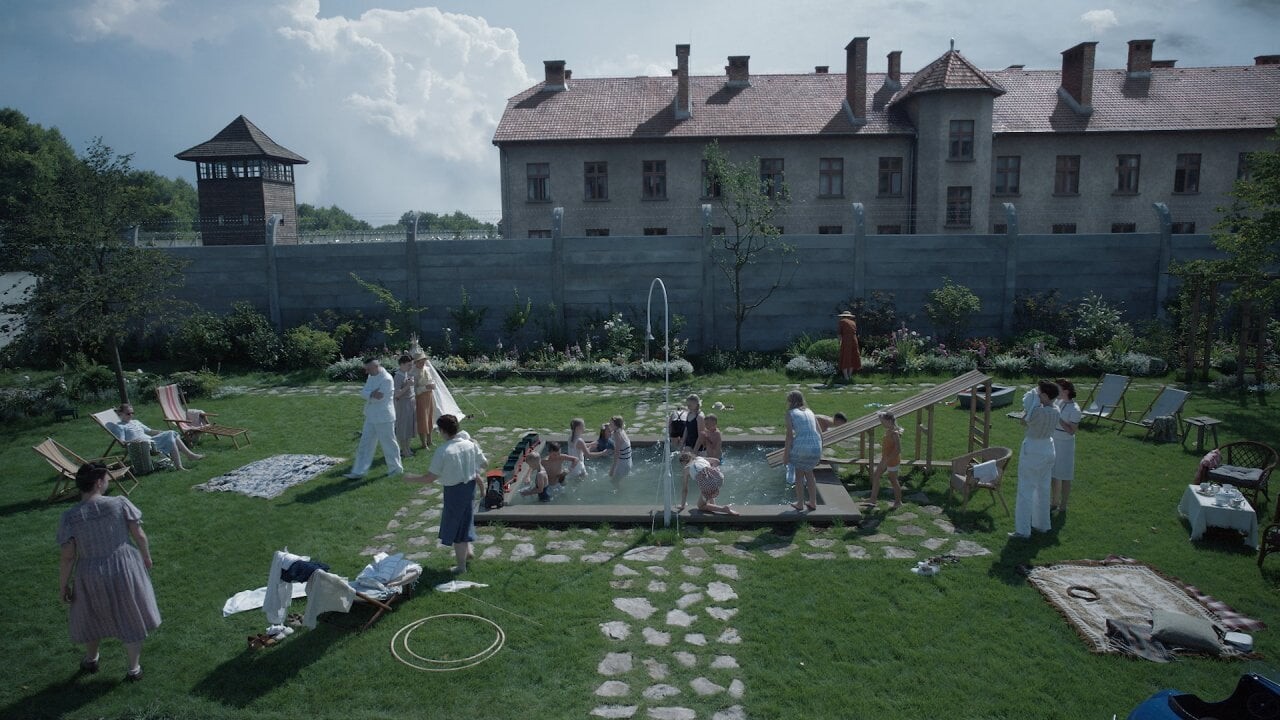
Still from Jonathan Glazer’s film The Zone of Interest.
It is at this point that we might recall the great adage of the German Jewish philosopher Theodor Adorno—and it seems almost inappropriate to be quoting it yet again—that all poetry is “barbaric” after Auschwitz. And he is right: all art does appear inadequate after the world’s great tragedies, conflicts, failures, and catastrophes, of which undoubtedly the Holocaust is one of the worst.
Can anyone truly believe that any work of art can capture the horror, the terror, the despair, maybe even the evil of what is currently taking place in the Middle East? That’s maybe one of the reasons behind the recent cancellation of Khaled Sabsabi: the resentment of the hubris of an artist who thinks he has something to say about such massive events as 9/11 and the rise of Hezbollah. And, equally, it is what seemed so inappropriate about his cancellation: that it could make the slightest difference to what was going on over there or even to what was taking place here.
And yet what else does the human race have after making all its mistakes, after committing all its evils, over and over again without learning any lessons, without changing itself or the world in any way, but art about these things?
I remember walking out stunned from the State Theatre after watching the full nine-hour version of Claude Lanzmann’s Shoah (1985) alone at the Sydney Film Festival as a relatively young man—I couldn’t persuade any of my other film-loving friends to watch it with me—thinking that my life was now utterly different.
I remember watching S21: The Khmer Rouge Killing Machine (2003), Rithy Panh’s documentary on the killing of some two million Cambodians between 1975 and 1979, and wondering whether my feeling that it wasn’t as good as Lanzmann’s Shoah was at all appropriate, or whether those kinds of aesthetic judgements, and everything that I was then and still am interested in, was somehow beside the point.
More recently still, I remember watching the last thirty minutes of Joshua Oppenheimer’s three-hour documentary The Act of Killing on the 1965–66 genocide in Indonesia, in which over one million “Communists” were tortured and murdered under President Suharto, and silently crying as perpetrator Anwar Congo retches on the nighttime rooftop while re-enacting his crimes, both at the incomprehensibility of what I was seeing and also, I came to realise, out of something like sympathy for someone who had personally killed over a thousand people by garrotting them with wire, with whom I had come to identify.
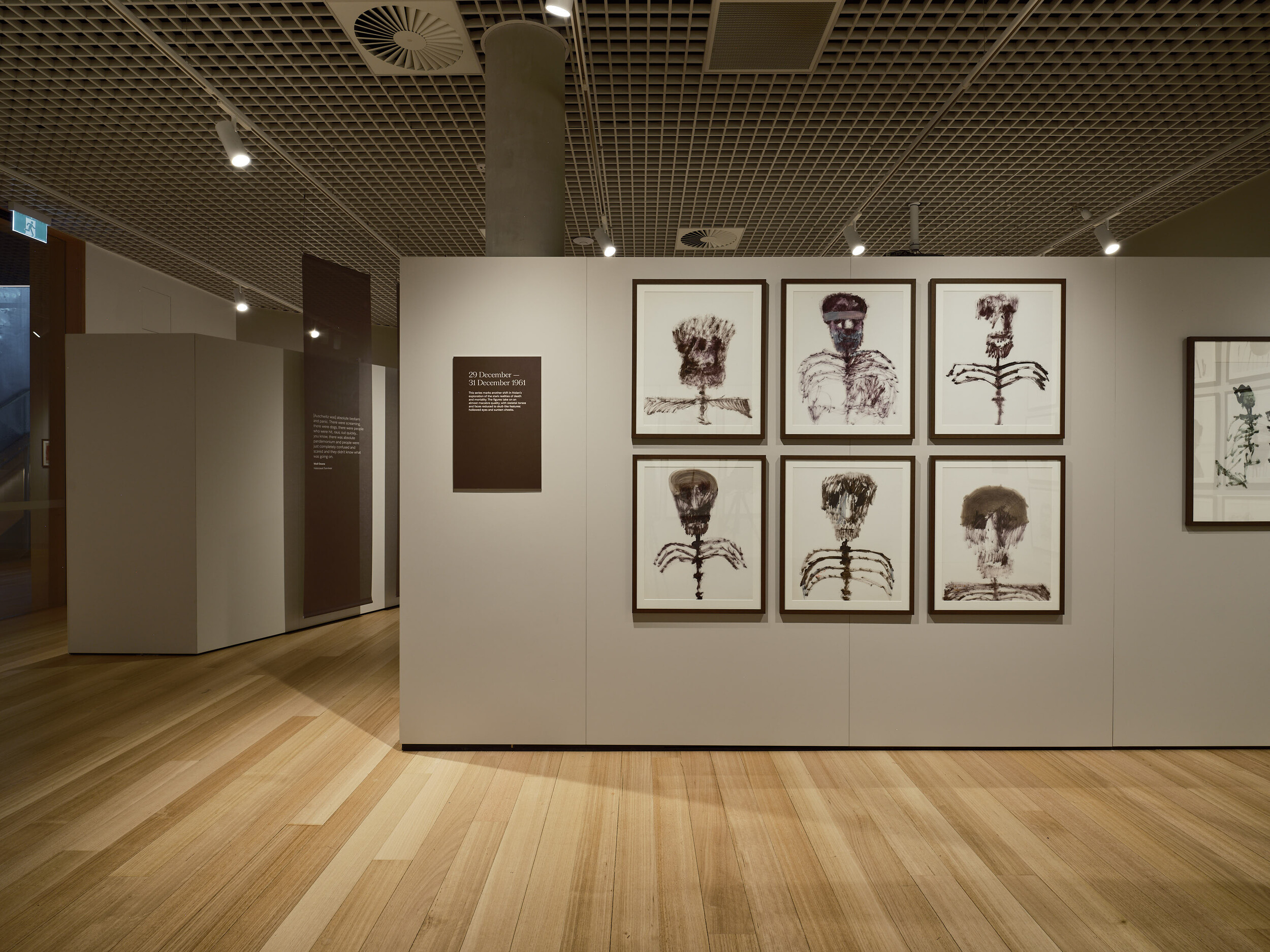
Installation view of Aftershocks: Nolan and the Holocaust, Melbourne Holocaust Museum. Photo: Simon Shiff
At the Melbourne Holocaust Museum until the end of June, there is an exhibition, Aftershocks: Nolan and the Holocaust, that features some fifty works on paper that Sidney Nolan made in response to the attempted Nazi extermination of Jewish people between 1941 and 1945.
Needless to say, at the front of the museum behind a glass window sits a guard who scans you as you enter. On the morning I went, a loud mechanical announcement from a nearby school was ordering a practice evacuation. The ongoing terrorist and humanitarian catastrophe in the Middle East is constantly in the news. Acts of anti-Semitism, such as the burning and graffitiing of synagogues, occur regularly here in Australia. In many ways, the Holocaust has not ended; its effects are still with us. And all of our actions—even those of Jewish people in Israel—are to be judged against it, though we can never definitively say what it stands for and we will always fall short of the moral lesson it offers us. It is a profound example of what philosophers call overdetermination, something that explains everything we do and say, exactly in its absence and repression.
Researcher and writer Andrew Turley, who curated the first exhibition of Nolan’s Holocaust paintings when they were shown at the Nolan Trust in Wales in 2021 and then organised their display at the Sydney Jewish Museum in 2022, makes the point in his original catalogue essay, now referred to by all who write on the works, that as early as 1939 Nolan was already responding to what was happening in the concentration camps when he painted in gouache across a newspaper image of Buchenwald that was reproduced in The Argus newspaper. He would continue to reflect upon it in 1944 when he made an image of a crematorium in Poland and in 1955 when he cut out a series of newspaper articles on the running of trains through Hungary taking Jewish people to Auschwitz. Indeed, in a hopefully productive provocation, we might even suggest that all of Nolan’s work after 1939 is in some way a response to the Holocaust, except those works in Aftershocks, which can be seen as something of an avoidance of its true horror. It is precisely not to suggest that we should not try to make art in response to what happened, for we must always attempt to do so, but rather that our efforts are insufficient, fail to rise properly to the status of art.
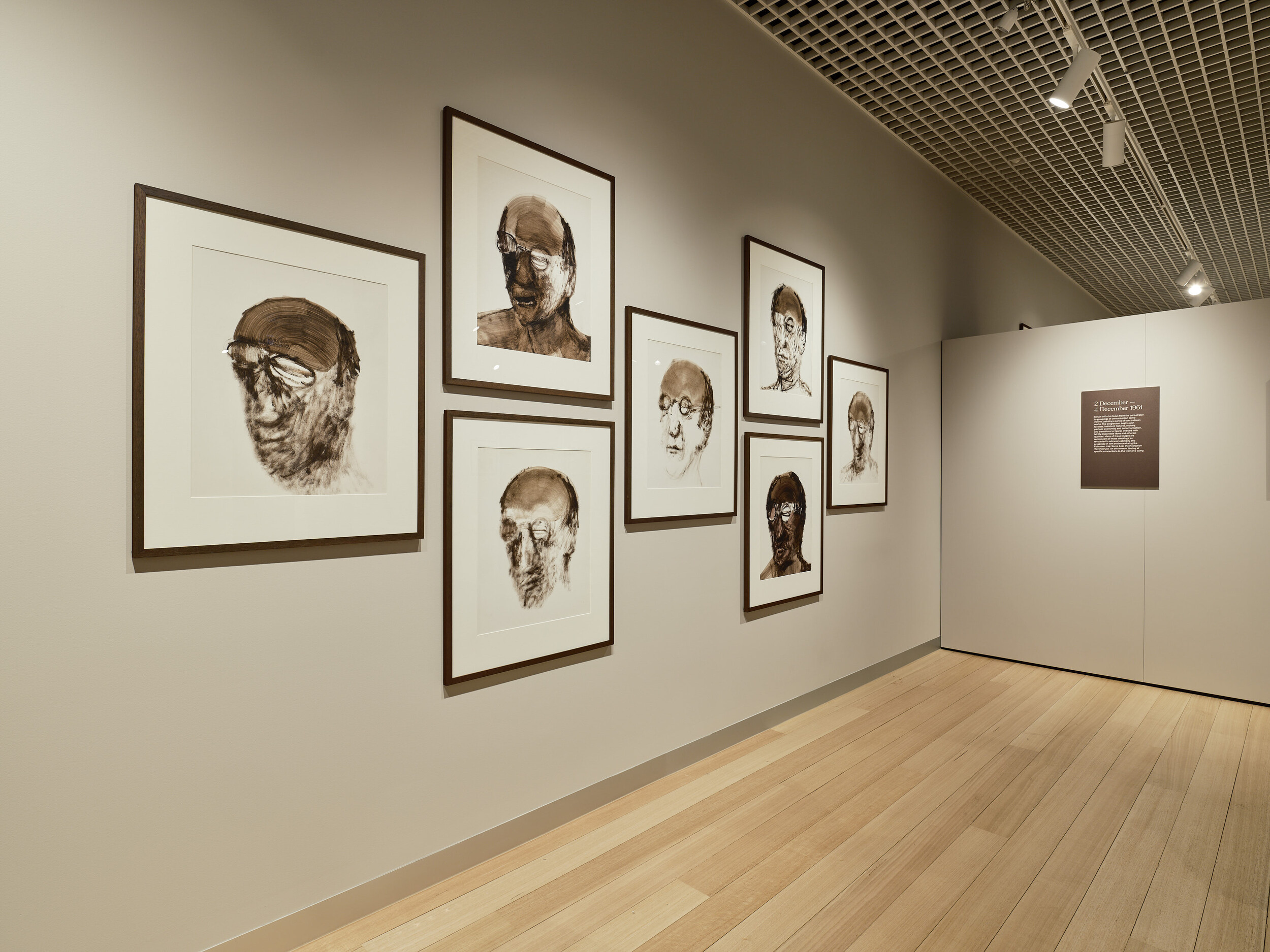
Installation view of Aftershocks: Nolan and the Holocaust, Melbourne Holocaust Museum. Photo: Simon Shiff
But perhaps to begin and fail ourselves. Aftershocks consists of some fifty works—once part of his estate and now in the collection of the Sydney Jewish Museum—that Nolan originally made between 1961 and 1962 in response to the televised trial of Adolf Eichmann, the notorious “special expert,” who so efficiently organised deportations to the death camps in the final years of the Third Reich and was responsible in many ways for the murder of some three million Jewish people.
Eichmann was captured by Israeli Mossad agents in Argentina in 1960 after almost fifteen years in hiding, brought to the relatively new state of Israel, and tried in a televised trial running from April to August 1961 that captured the world’s attention and led to the German Jewish philosopher and political theorist Hannah Arendt, who attended the trial, writing of the “banality of evil” in her era-defining essay “Eichmann in Jerusalem: A Report on the Banality of Evil,” which was originally published in The New Yorker.
Arendt’s point was that, unlike the mesmerizingly evil figure of Adolf Hitler—one of the human images of the devil amongst us—Eichmann looked and behaved like an anonymous bureaucrat as he sat mute and undemonstrative throughout the trial in black suit and tie and glasses, following the procedure carefully. He displayed no shock when he was sentenced to death and stood up obediently to be led out of the dock after the judges read their sentence, unrepentant, and unconfessing, and yet somehow like a good bureaucrat acknowledging the correctness of the verdict, in one of the most haunting and enigmatic moments of the whole trial. He is like us and yet absolutely unlike us, although it is through him that we are led to ask the question: What would we have done in similar circumstances? Don’t all of us ultimately compromise and disgrace ourselves by following an abstract procedure whose real-life effects seem so far away? (I live in colonial Australia and work at a university, so I know what I’m talking about. I too, like Eichmann famously said in his defence, would insist that I am only “a middle-ranking officer obeying orders.”)
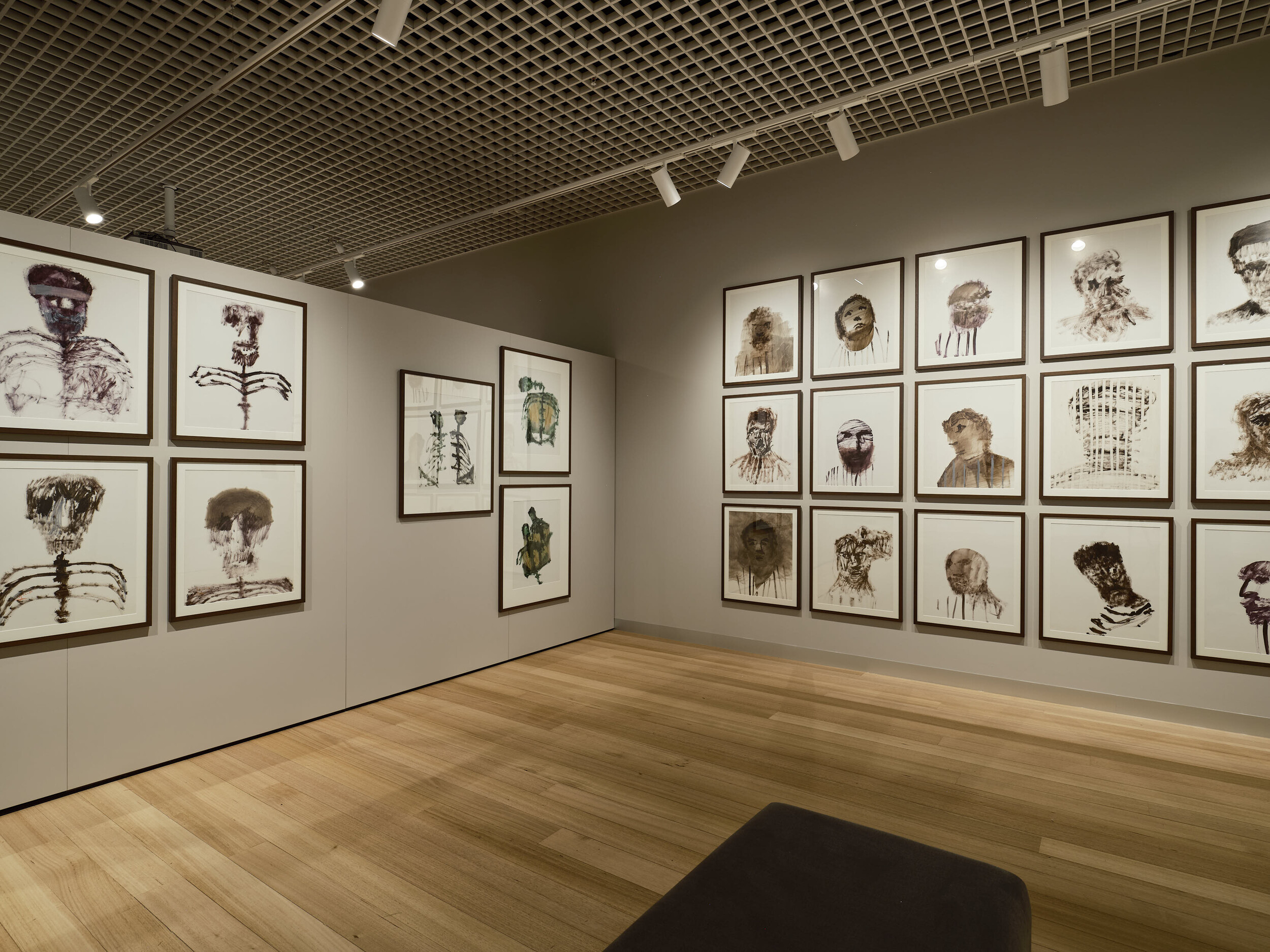
Installation view of Aftershocks: Nolan and the Holocaust, Melbourne Holocaust Museum. Photo: Simon Shiff
Nolan, after the trial, produced a dozen portraits of Eichmann, of which some six are in the show. What might we say about them? Turley, in an interview for the Sydney exhibition, spoke of Nolan’s work in general in relation to Francis Bacon’s Three Studies for Figures for the Base of a Crucifixion (1944), but it is perhaps his Study after Velázquez’s Portrait of Pope Innocent X, aka The Screaming Pope (1953), to which we might more closely compare these portraits of Eichmann. The brilliance of Bacon’s remake is that he brings out the barely suppressed disdain, we are even tempted to say violence, in Velázquez’s original, with the bitterly clenched lips and near-contemptuous stare of the Pope. (God knows how the Pope’s advisors back then ever allowed him to get away with his savagely unsympathetic depiction.) We get the same ominous feeling of repressed violence and contempt in Nolan’s portraits of Eichmann: on the surface the usual glassy stare, but beneath it a ghostly and unlocatable smile or grimace appears to be bubbling up, laughing at the world and our judgement upon him.
How does Nolan achieve this effect? One explanation is his choice of colour: a caput mortuum or mummy brown, a paint once made from the flesh and bone of embalmed people and, by Nolan’s time, artificially. But also—a brilliant but probably unaware, in the heat-of-the-moment choice—the decision not to mix the pigment with oil, so that the paint does not soak into the paper but sits on top in a scratchy, desiccated way without obvious depth, as though there were something invisible immediately behind it.
Then, over the next two months, from December 1961 to January 1962, Nolan embarked on four discrete series of works, totalling some 220 altogether, directly responding to the revelations of the trial.
First, from 16 to 18 December, he painted a series of portraits of prisoners in their “labour camp” stripes (and particularly brilliant here is Nolan’s use of the white of the paper to stand in for the infamous “Arbeit macht frei” uniforms, as though it were also imprisoning them). Then from 23 December he painted smoke rising out of the prisoners’ mouths, which evokes both the crematoria in which their corpses were burnt and the message they have to tell us. From 29 December—and God knows what kind of Christmas he and his family had that year—he painted still-fleshy heads above skeletal rib cages, as though they were bird’s wings waiting to take them away. And in early January, he painted smoke rising from crosses, gesturing towards both the smoke rising out of the crematoria and—the best he could do—the Christian emblem of resurrection.

Installation view of Aftershocks: Nolan and the Holocaust, Melbourne Holocaust Museum. Photo: Simon Shiff
They’re all in Aftershocks, arranged in imposing, grid-like hangs in their different series. Maybe Nolan didn’t originally intend them this way—Turley speaks of them coming about out of an unstoppable and uncontainable impulse—but ultimately it is their seriality that is their meaning. We can stand in front of and admire any individual one—and some of them are extremely compelling, such as the one of a body taken off a cross and carried away in a wheelbarrow, which reminds us at once of all those great paintings of the Descent from the Cross and the fact that it was a twisted Aryan Christian ideology that itself led to the Holocaust—but each is also diminished, made modest, even insignificant, by the fact that there are so many others like them. The work of art does not sit above whom and what it depicts, but is only another one of them. It is almost as though, Nolan seems to be saying, he could go on forever recording what happened, giving each victim their due, and it is only his human exhaustion and the passage of time that prevents him from doing so.
In fact, arguably prompting Nolan’s reflections, in July 1961 the artist had been visited by his good friend, the poet and critic Al Alvarez, who came to see whether he would be prepared to accompany him to Auschwitz to illustrate an article he had been commissioned to write for The Observer newspaper. After some hesitation, Nolan accepted, and they left in January 1962 to visit first Poland and then Auschwitz, in which over one million Jewish people lost their lives as part of the so-called Final Solution.
Again, almost everyone who writes on this “episode” in Nolan’s career—and, of course, it is patronising and arguably misleading to speak of it like this—quotes the series of remarks made by the two men after their visit, from Alvarez saying after seeing the crowded barracks in which the men slept that they were like “battery hens waiting to be slaughtered” to Nolan comparing the regular geometrical layout of the camp to a “bloody Mondrian.” But perhaps the properly significant fact is that Nolan was ultimately unable to fulfil his commission. And Turley makes the point that Nolan refused to speak about both it and those works he made on the subject—it was Turley who in fact discovered them unknown in Nolan’s estate in 2012 when he was undertaking research on Nolan’s later, known tour to Africa—but that numerous works he made afterwards can implicitly be seen to be responding to the same subject. (Turley convincingly makes the case that the gorillas Nolan depicts during his 1962 trip to Uganda and then to the war-torn Congo stand in for Nazi soldiers.)
Nolan was not, in fact, the only Australian artist to depict not the functioning death camps themselves—for that, of course, was impossible—but their liberation and the subsequent bringing of their enablers to justice. The war artist photographer Alan Moore was amongst the first to be allowed into Bergen-Belsen and made a series of extraordinary images of the newly freed inmates lining up along a road in their striped uniforms, too weak to cheer as their captors were rounded up and driven away in trucks. Colin Colahan, who is incidentally in the beautiful Tonalism exhibition at the Hawthorn Arts Centre, made haunting paintings of camp guards in jail awaiting trial, the dappled greens, browns, and yellows of his palette pointing to the ambiguities and not clear-cut black-and-white certainties of the issues opened up. Are we truly unlike these men? Were the Allies themselves innocent of all war crimes? What is the proper nature of the justice to be meted out to these predominantly lower-ranked functionaries and not instigators?

Installation view of Aftershocks: Nolan and the Holocaust, Melbourne Holocaust Museum. Photo: Simon Shiff
And let’s not get too far ahead of ourselves on the unquestioned virtue and moral purity of Nolan. Already in 1940, he had made a theatrical backdrop for the Russian-French ballet dancer Serge Lifar, who would soon after become an infamous collaborator with the Nazis when they invaded Paris, offering to put on a performance for the officers in celebration of their victory, and once even implausibly claiming, while stroking the arm of a compliant young man, that “only two men have caressed me like this, Diaghilev and Hitler.” And later in 1981, when some of this was better known, Nolan all too temptingly appeared with Lifar at the Sydney Opera House when he was selling pen-and-ink versions of his now-acclaimed stage setting. Let alone the fact that in the late 1930s, when in Turley’s account he had already worked with photographs of Buchenwald, he avoided proper war service and even ran away from the rather unonerous job of protecting the wheatfields of western Victoria from invasion. This was when he was inspired to begin his Wimmera series of landscapes, which he hid in his various patrons’ houses (for example, the Reeds’), while he stayed one step ahead of the military police. Actually, they’re such great, paradigm-shifting depictions of the Australian landscape, leading to Fred Williams, John Olsen, William Robinson, you name it, that I’m prepared to forgive him.
“Forgiveness,” too, had always been part of Arendt’s philosophy. In her famous lecture “On Forgiveness,” delivered after the war and already in full knowledge of the Nazis’ Final Solution, she says, “Only through this constant mutual release from what they do can men remain free agents; only by constant willingness to change their minds and start again can they be trusted with so great a power as that to begin something new.” The subsequent trial of Eichmann undoubtedly challenged her, but she never gives up the idea that forgiveness is necessary—a forgiveness that we are never entirely able or even willing to give, but a forgiveness that we should aspire to and that we must judge both our own and others’ actions against. Again, as she says in “On Forgiveness,” in magnificent Biblical-, Torah- and Koran-like words of the way that forgiveness is perhaps the only free act and the only act that allows us to start again from the beginning:
In contrast to revenge, which is a natural, automatic reaction to transgression and which because of the irreversibility of the action process can be expected and even calculated, the act of forgiving can never be predicted; it is the only reaction that acts in an unexpected way and thus retains, though being a reaction, something of the original character of action.
It is a “forgiveness” that we have all too quickly forgotten today when we want to judge artists by their past sins, their past mistakes, their past miscalculations. In a profound way, Nolan put the work behind him and never mentioned it again because—but the meaning of the word is complicated, not simple—he “forgave.” He precisely did not want to let the traumatic meaning and consequences of the Holocaust determine everything about our world, how we should carry on, how we should treat and behave towards others.
It is almost impossible, but we must look forward, not back. It is ultimately the profound lesson of the Holocaust exhibition on the same level as the Nolan show, which relates the stories of a number of Jewish refugees who came to Australia to make lives for themselves after the Holocaust. “Mum’s father, who died in her arms in Theresienstadt, told her to become a ‘citizen of the world.’ She took that very seriously, and after surviving the camps, she was on a mission. She became a voice for those who were not able to speak up for themselves,” says the daughter of Irene Capek in the didactic, and this is perhaps the true “aftershock” of Aftershocks. What Nolan leaves behind for us is not so much the works themselves, which are dark, haunting, and depressing, but the belief required to make them.
Because even when Nolan was making his original concentration camp works in 1939, he could only be making them for a world that was better than the one he was depicting.
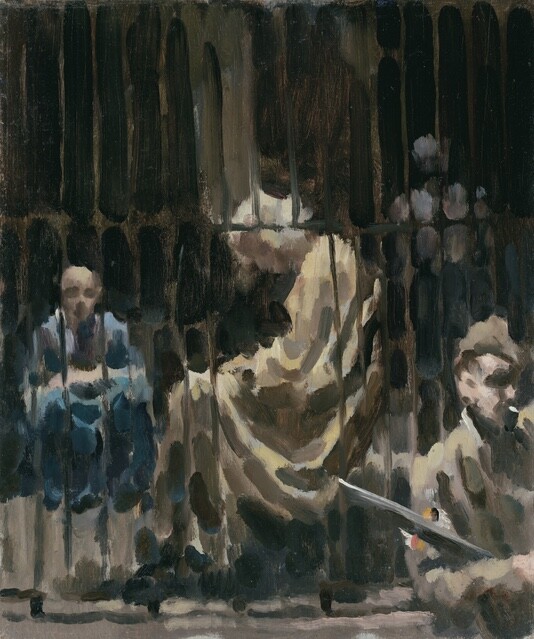
Colin Colahan, Collaborators in the Lions’ Cage at Antwerp, oil on wood, 45.8 × 38 cm (62 × 54.5 × 4.5 cm framed), Antwerp, Flanders, September 1944. Australian War Memorial, ART25707. Public domain.
It is a future that Turley generously granted Nolan’s works when he discovered them in the archive and brought them out to exhibit. Nolan originally put them away, but he did not destroy them, undoubtedly because he believed that one day in the future, even after Eichmann and Auschwitz, a world would exist in which they could be seen and responded to. That world exists in Melbourne in 2025.
